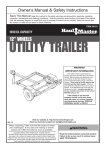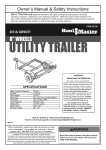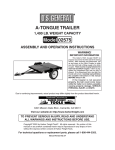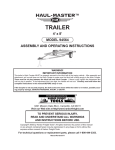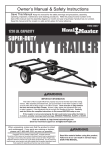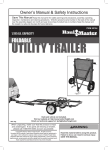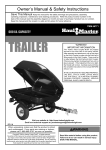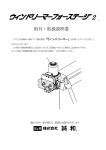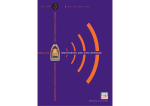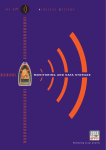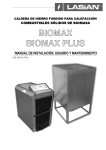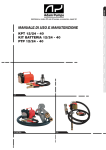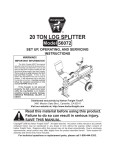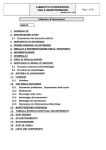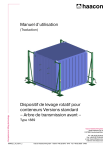Download Harbor Freight Tools 92174 User's Manual
Transcript
TRAILER WITH TAILGATE (1,560 LB. WEIGHT CAPACITY) Model 92174 Assembly And Operation Instructions WARNING! IMPORTANT INFORMATION This trailer’s Hitch Coupler MUST be properly secured to the hitch ball of the towing vehicle. After assembly and attachment, pull up and down on the Hitch Coupler to make sure the hitch ball is fitting snugly in the Hitch Coupler. There must be no play between the hitch ball and Hitch Coupler. If there is play, tighten the Adjustment Nut until no play is present. If the Adjustment Nut is too tight, the Handle will not lock. Carefully read and follow the complete instructions in this manual BEFORE setup or use. If the Coupler is not secured properly, the ball could come loose while the trailer is in motion, possibly causing property damage, SERIOUS PERSONAL INJURY, or DEATH. Due to continuing improvements, actual product may differ slightly from the product described herein. ® 3491 Mission Oaks Blvd., Camarillo, CA 93011 Visit our website at: http://www.harborfreight.com To prevent serious injury, read and understand all warnings and instructions before use. Copyright© 2004, 2007 by Harbor Freight Tools®. All rights reserved. No portion of this manual or any artwork contained herein may be reproduced in any shape or form without the express written consent of Harbor Freight Tools. For technical questions or replacement parts, please call 1-800-444-3353. Manual revised 07e Contents SPECIFICATIONS..................................................................................... 3 UNPACKING............................................................................................. 3 GENERAL SAFETY RULES..................................................................... 3 Work Area.............................................................................................................. 4 Equipment Use and Care...................................................................................... 4 Service................................................................................................................... 5 SPECIFIC PRODUCT WARNINGS AND PRECAUTIONS....................... 5 ASSEMBLY INSTRUCTIONS................................................................... 7 OPERATING INSTRUCTIONS................................................................. 14 Tire information............................................................................... 15 Tire Terminology Glossary.................................................................................. 15 Tire Markings........................................................................................................ 16 Tire Inflation and Load Limit............................................................................... 17 Tire care.............................................................................................. 18 Checking Tire Pressure....................................................................................... 18 Steps for Maintaining Proper Tire Pressure...................................................... 18 Tire Size................................................................................................................ 19 Tire Tread.............................................................................................................. 19 Tire Rotation......................................................................................................... 19 Tire Balance and Alignment................................................................................ 19 Tire Repair............................................................................................................ 19 Vehicle Load Limit............................................................................. 20 Steps for Determining Correct Load Limit......................................................... 20 INSPECTION, MAINTENANCE, AND CLEANING.................................. 21 PARTS LIST............................................................................................. 22 Hardware List....................................................................................................... 22 ASSEMBLY DIAGRAM............................................................................ 23 LIMITED 90 DAY WARRANTY................................................................. 24 REV 07e SKU 92174 For technical questions, please call 1-800-444-3353. Page SPECIFICATIONS Maximum Weight Capacity 1,560 Pounds Maximum Towing Speed 45 MPH Overall Dimensions 112” L x 61-5/8” W x 26” H Main Frame Dimensions 71-5/8” L x 49” W Tailgate Dimensions 30-3/8” L x 43-1/4” W Ground Clearance Dimensions 7-1/4” From Ground to Axle Tires Qty: 2 / DOT Approved Maximum Permissible Inflation Pressure: 60 PSI Size: 4.80-12 Hitch Type Class II Hitch Dimensions 9-3/8” L x 2-3/4”~3-3/4” W x 2”~4-1/2” H x 1/8” Thick Tongue Dimensions 2” Square Ball Size 2” Light Voltage Requirements 12 Volts DC Weight 246.5 Pounds UNPACKING When unpacking, make sure all the parts and hardware shown on the Parts List/ Hardware List are included. If any parts are missing or broken, please call Harbor Freight Tools at the number shown on the cover of this manual as soon as possible. Save This Manual You will need this manual for the safety warnings and precautions, assembly, operating, inspection, maintenance and cleaning procedures, parts list and assembly diagram. Keep your invoice with this manual. Write the invoice number on the inside of the front cover. Keep this manual and invoice in a safe and dry place for future reference. GENERAL SAFETY RULES IMPORTANT SAFETY INSTRUCTIONS WARNING! Read and adhere to the following instructions. Failure to read and obey all of the following instructions COMPLETELY will void the warranty and can result in damage to the Trailer, property damage, or SERIOUS PERSONAL INJURY. SAVE THESE INSTRUCTIONS. REV 05k, 07h SKU 92174 For technical questions, please call 1-800-444-3353. Page Work Area 1. Keep work area clean and dry. Cluttered, damp, or wet work areas invite injuries. 2. Keep children away from work area. Do not allow children to play in, climb on or ride in this product. 3. Store idle equipment. When not in use, tools and equipment should be stored in a dry location to inhibit rust. Always lock up tools and equipment, and keep out of reach of children. 4. Do not use this product if under the influence of alcohol or drugs. Read warning labels on prescriptions to determine if your judgement or reflexes are impaired while taking drugs. If there is any doubt, do not attempt to use this product. 5. Use eye protection. Wear ANSI-approved safety impact eye goggles when assembling this product. ANSI-approved safety impact eye goggles are available from Harbor Freight Tools. 6. Dress safely. Do not wear loose clothing or jewelry, as they can become caught in moving parts. Wear a protective hair covering to prevent long hair from becoming caught in moving parts. If wearing a long-sleeve shirt, roll sleeves up above elbows. 7. Do not overreach. Keep proper footing and balance at all times to prevent tripping, falling, back injury, etc. 8. Industrial applications must follow OSHA requirements. 9. Stay alert. Watch what you are doing at all times. Use common sense. Do not use this product when you are tired or distracted from the job at hand. Equipment Use and Care 1. Check for damaged parts. Before using this product, carefully check that it will operate properly and perform its intended function. Check for damaged parts and any other conditions that may affect the operation of this product. Replace or repair damaged or worn parts immediately. 2. Replacement parts and accessories: When servicing, use only identical replacement parts. Only use accessories intended for use with this product. Approved accessories are available from Harbor Freight Tools. 3. Maintain this product with care. Keep this product clean and dry for better and safer performance. 4. Maintenance: For your safety, service and maintenance should be performed regularly by a qualified technician. SKU 92174 For technical questions, please call 1-800-444-3353. Page 5. Use the right equipment for the job. Do not attempt to force small equipment to do the work of larger industrial equipment. There are certain applications for which this product was designed. It will do the job better and more safely at the capacity for which it was intended. Do not modify this product, and do not use this product for a purpose for which it was not intended. Service 1. Equipment service must be performed only by qualified repair personnel. Service or maintenance performed by unqualified personnel could result in a risk of injury. 2. When servicing equipment, use only identical replacement parts. Follow instructions in the “Inspection, Maintenance, and Cleaning” section of this manual. Use of unauthorized parts or failure to follow maintenance instructions may create a risk of personal injury. SPECIFIC PRODUCT WARNINGS AND PRECAUTIONS 1. To avoid personal injury and/or property damage, do not exceed the Trailer’s maximum weight capacity of 1,560 pounds. 2. Before each use, always examine the Trailer for proper Tire air pressure (60 PSI), damaged tail lights, damaged side running lights, loose bolts and nuts, structural cracks and bends, and any other condition that may affect its safe operation. Do not use the Trailer even if minor damage appears. 3. Never allow adults, children, or pets to ride in or play on the Trailer. 4. Before each use, always attach the Safety Chain of the Trailer to the towing vehicle. Make sure the Safety Chain is attached to the towing vehicle with the same length for each side. Do not allow the Safety Chain to drag on the ground. 5. Always check to make sure the payload being transported is properly and safely secured in the Trailer. Load the Trailer evenly from side to side with 60% of the load forward of the Axle. 6. Prior to using the Trailer, make sure to read and understand all instructions and safety precautions as outlined in the owner’s manual for the towing vehicle. Make sure the towing vehicle is capable of towing the Trailer and its payload. Make sure the hitch on the towing vehicle is capable of towing the Trailer and its payload. The towing capacity of the hitch is typically stamped on the hitch drawbar. 7. Make sure the Coupler and the vehicle’s ball hitch (not included) are of equal mating size (2”) and are rated equal to or greater than the weight of the Trailer and its payload. SKU 92174 For technical questions, please call 1-800-444-3353. Page 8. Do not exceed 45 miles per hour when towing the Trailer. Excess speed is a major cause of vehicle-trailer accidents. Poor road conditions, such as uneven, wet, or unstable surfaces, will create further hazards if driven on too quickly. Reduce speed to a safe level when driving in poor driving situations. 9. The Tail Light Bulbs supplied with this Trailer are for a 12 volt DC electrical system only. Do not attempt to power the Light Bulbs with any other type or voltage electrical current. 10. Whenever possible, park the Trailer on a flat, level, paved, surface and chock both Tires to keep the Trailer from accidently moving. 11. CAUTION! Care must be taken when backing up the Trailer. Only back up the Trailer on a straight path. If the Trailer is allowed to turn off the straight path while backing up, the Trailer could jackknife, causing severe damage to the Trailer and towing vehicle. 12. Maintain labels and nameplates on the Trailer. These carry important information. If unreadable or missing, contact Harbor Freight Tools for a replacement. 13. Reporting safety defects: If you believe your Trailer has a defect which could cause a crash or could cause injury or death, you should immediately inform the National Highway Traffic Safety Administration (NHTSA) in addition to notifying the manufacturer, Changzhou Nanxiashu Tool Company. If NHTSA receives similar complaints, it may open an investigation, and if it finds that a safety defect exists in a group of vehicles, it may order a recall and remedy campaign. However, NHTSA cannot become involved in individual problems between you, Harbor Freight Tools, or the manufacturer. To contact NHTSA, you may either call the Auto Safety Hotline toll-free at 1-800-424-9393 or 202-366-0123 or write NHTSA, U.S. Department, 400 7th Street SW NSA-11, Washington, D.C. 20590. You may also obtain other information about motor vehicle safety from the Hotline. 14. Trailer licensing notice: Some states may consider this Trailer a vehicle requiring registration, licensing, and titling. Check with your State Department of Motor Vehicles for information and guidance on registering, licensing, and titling the Trailer. 15. WARNING: The warnings, precautions, and instructions discussed in this manual cannot cover all possible conditions and situations that may occur. The operator must understand that common sense and caution are factors, which cannot be built into this product, but must be supplied by the operator. SAVE THESE INSTRUCTIONS SKU 92174 For technical questions, please call 1-800-444-3353. Page ASSEMBLY INSTRUCTIONS Note: For additional references to the parts listed on the following pages, refer to the Assembly Diagram. A1 2 A20 2 6 A21 A2 2 2 1 A9 A20 A13 2 8 FIGURE A 1. Attach the Tow Bar (A2) to the underside of the frame assembly, using two Bolts (1), Lock Nuts (1), and Washers (1). (See Figure A.) 2. Attach the ends of two Side Rails (A20) to the front end of the Trailer Frame (A1), using four Bolts (2), Lock Nuts (2), and Washers (2). Then attach the remaining two ends of the Side Rails to the Tow Bar (A2), using the “T” Plate (A21), four Bolts (2), Lock Nuts (2), and Washers (2). Secure the Center with one Bolt (6), Lock Nut (6), and Washer (6). (See Figure A.) BOLT 3. 4. Slide the Hitch Coupler (A9) onto the end of the Tow Bar (A2), and align the two mounting holes of the Hitch Coupler with the two side mounting holes of the Tow Bar. (See Figures A and B.) Locate the center link in the Safety Chain (A13), and place the center link inside the end of the Tow Bar (A2). Insert a Bolt (8) horizontally through the side/forward mounting hole of the Hitch Coupler (A9), TOW BAR (A2) (8) HITCH COUPLER (A9) SAFETY CHAIN (A13) FIGURE B REV 05k, 06b, 07e SKU 92174 For technical questions, please call 1-800-444-3353. Page through the center link in the Safety Chain, and through the Tow Bar. Firmly tighten a Lock Nut (8) onto the Bolt (8) to secure the Safety Chain to the Tow Bar. Insert another Bolt (8) through the side/rear mounting holes of the Hitch Coupler and Tow Bar and secure with a Lock Nut (8). (See Figures A and B.) With assistance, turn the Frame and Tow Bar assembly upside down. 5. U-BOLT (3) TRAILER FRAME (A1) AXLE (A6) TRAILER SPRING (A8) Cotter Pin (7) NUT (7) Cotter Pin (7) NUT (7) BOLT (7) SPRING PLATE (3) SPRING HANGER BOLT (7) LOCK NUT and Washer (3) FIGURE C 6. Place the two Trailer Springs (A8) in the spring hangers located on the underside of the Trailer Frame (A1). Secure each Trailer Spring to the Trailer Frame, using two Bolts (7), two Nuts (7), and two Cotter Pins (7). (See Figure C.) 7. Place the Axle (A6) on top of the Trailer Springs (A8). Position a Spring Plate (3) under each Trailer Spring. Place two U-Bolts (3) over each end of the Axle and through each Spring Plate. Then secure the Axle to the Spring assembly, using four Lock Nuts (3) and Spring Washers (3) for each end of the Axle. (See Figure C.) REV 06b, 07e SKU 92174 For technical questions, please call 1-800-444-3353. Page WARNING! If the following procedure is not followed, it may result in wheel locking and tire blowout, causing an automobile accident or road hazard. Whenever a Hub (A7) on a new unit requires assembly (or a Hub is disassembled for maintenance), the following procedures MUST be followed: 8. a. Using a suitable solvent, thoroughly clean the Bearings (A7), Seal (A7), Cap (A7), and the rest of the parts of the Hub assembly of all grease, dirt, metal shavings, or any other foreign object. The parts must be cleaned even if they are new or appear clean. b. Allow all parts to dry completely. c. Make sure your hands are clean and the bearing packer (not included) is also clean. d. Place fresh, clean bearing grease in the bearing packer. e. With the grease-filled bearing packer in one hand and the Bearing (A7) in the other, press the Bearing into the grease, forcing the grease inside the slots in the Bearing. Continue doing this until every slot in the Bearing is completely full of grease. As you finish assembling the Hub, be careful not to get any dirt or debris on any part of the assembly. 9. COTTER PIN (A7) AXLE (A6) LUG NUT (A7) (LUBRICATE EVERY 90 DAYS) GREASE FITTING LUG NUT (A7) HUB (A7) TIRE & RIM (A10) BEARINGS (A7) FLAT WASHER (A7) CASTLE NUT (A7) CAP (A7) FIGURE D 10. Carefully slide the Hubs (A7) over the Spindles at each end of the Axle (A6). Insert the Bearings (A7) and the Flat Washer (A7) on the Spindles. Screw a Castle Nut SKU 92174 For technical questions, please call 1-800-444-3353. Page (A7) tightly onto each Spindle. Then back the Castle Nuts off slightly so that the Hubs can just move freely. (See Figure D, above.) 11. Insert a Cotter Pin (A7) through the hole at the end of each Spindle of the Axle (A6) and spread the Cotter pin. (See Figure D.) 12. Fill the Caps (A7) with bearing grease. Then, press each Cap onto the Hubs (A7). (See Figure D.) 13. With assistance, turn the Trailer over so that it is facing correct side up. LEFT TAIL LIGHT (A15) BOLT (2) RIGHT TAIL LIGHT (A16) FIGURE E TAIL LIGHT BOLT BRACKET (2) (A18) SIDE RUNNING LIGHT (A19) FENDER (A11) FENDER SUPPORT BAR (A14) BOLT (2) 14. Attach the Tail Light Brackets (A18) to the right/rear and left/rear of the Trailer Frame (A1), using two Bolts (2), Lock Nuts (2), and Washers (2) for each Tail Light Bracket. (See Figure E.) 15. Attach the Right Tail Light (A16) to the right side Tail Light Bracket (A18), using the two Nuts that are factory pre-attached to the Right Tail Light. (See Figure E.) 16. Attach the License Plate Bracket (A17) and Left Tail Light (A15) to the left side Tail Light Bracket (A18), using the two Nuts that are factory pre-attached to the Left Tail Light. (See Figure E.) 17. Remove the Lens from a Side Running Light (A19). Insert the Wire Lead of the Side Running Light through the center hole in the right/forward side of the Trailer Frame (A1). Attach the Side Running Light to the Trailer Frame, using the two accessory Self Tapping Screws. Then, reattach the Lens to the Side Running Light. Repeat this procedure for the remaining Side Running Light on the left/forward side of the Trailer Frame. (See Figure E.) SKU 92174 For technical questions, please call 1-800-444-3353. Page 10 18. Attach a Fender (A11) to the right/middle section of the Trailer Frame (A1) and left/ middle section of the Trailer Frame, using one Fender Support Bar (A14), two Bolts (2), Lock Nuts (2), and Washers (2) for each Fender. (See Figure E.) 19. Place a Tire w/Rim (A10) on each Hub (A7). Secure the Tire w/Rims to the Hubs, using four Lug Nuts (A7) per Tire. NOTE: Make sure to tighten (torque) the Lug Nuts to at least 90 ft-lb. (See Figure D, page 9.) TRAILER ENCLOSURE (A12) SUPPORT BAR (A3) REAR CORNER BRACE (A4) USE BOLTS (2) NUTS (2) Cotter PIN (5) REAR CORNER BRACE (A4) REAR RAMP (A5) TRAILER FRAME (A1) PIN (4) FIGURE F 20. To attach the Trailer Enclosure (A12) to the Trailer Frame (A1), attach the lower portion of the eight Support Bars (A3) to the front, left, and right sides of the Trailer Frame, using one Bolt (2), Lock Nut (2), and Washer (2) for each Support Bar. Attach the Trailer Enclosure to the top portion of each of the eight Support Bars. Attach the lower portion of a Rear Corner Brace (A4) to the left/rear and right/ rear corners of the Trailer Frame. Then, attach the Trailer Enclosure to the top portion of both Corner Braces. (See Figure F.) 21. To install the Rear Ramp (A5), insert the two Inner Hinges located at the bottom of the Rear Ramp into the two Outer Hinge Slots located at the rear of the Trailer Frame (A1). Insert the two Pins (4) through the two Outer Hinge Slots and Inner Hinges. Then secure the Pins in place with the two Cotter Pins (5). (See Figures F and G.) REV 05c SKU 92174 For technical questions, please call 1-800-444-3353. Page 11 PIN LOCK PIN LOCK PIN (4) TRAILER FRAME (A1) INNER HINGE & OUTER HINGE SLOT 22. Cotter PIN (5) FIGURE G Cotter PIN (5) PIN (4) INNER HINGE & OUTER HINGE SLOT Raise the Rear Ramp (A5) to its up position. Then, lock the Rear Ramp in place with the two Pin Locks. (See Figure G.) REV 05c SKU 92174 For technical questions, please call 1-800-444-3353. Page 12 WHITE (GROUND) WIRE CLIP YELLOW GREEN WIRE FROM SIDE RUNNING LIGHT (A19) WIRE FROM SIDE RUNNING LIGHT (A19) BROWN BROWN RIGHT SIDE TRAILER FRAME (A1) LEFT SIDE TRAILER FRAME (A1) LEFT TAIL LIGHT (A15) BROWN RIGHT TAIL LIGHT (A16) YELLOW GREEN BROWN FIGURE H 23. To install the Wiring Harness on the Trailer, use an accessory Self Tapping Screw to attach the White Ground Wire located at the Plug end of the Wiring Harness to the small mounting hole in the Tow-bar (A2). (See Figure H.) 24. Leave about 18” of wire beyond the Hitch Coupler (A9), and run the Wiring Harness along the inside of the Tow-bar (A2) to the front of the Trailer Frame (A1). Then, split the Yellow/Brown Wires from the Green/Brown Wires. (See Figure H.) 25. Run the Yellow/Brown Wires along the inside of the front of the Trailer Frame (A1) to the Side Running Light (A16) located on the left/forward side of the Trailer Frame. Then, run the Green/Brown Wires along the inside of the front of the Trailer Frame to the other Side Running Light located on the right/forward side of the Trailer Frame. (See Figure H.) 26. Run the Green/Brown Wires to the Right Tail Light (A16). Strip the ends of the Wires about 3/4”. Connect the Green Wire to the Red Wire of the Right Tail Light. Then, connect the Brown Wire to the two Black Wires of the Right Tail Light. (See Figure G.) 27. NOTE: It is recommended that only a qualified technician perform the electrical service that may be needed to enable your particular make/model vehicle to power the Trailer’s 12 volt DC lighting system. SKU 92174 For technical questions, please call 1-800-444-3353. Page 13 OPERATING INSTRUCTIONS TRIGGER “R” PIN HANDLE SAFETY PIN ADJUSTMENT NUT HITCH COUPLER (A9) HITCH BALL (NOT INCLUDED) SAFETY CHAIN (A13) FIGURE I 1. Only use a 2” ball hitch (not included) on the towing vehicle. (See Figure I.) 2. NOTE: To reduce friction between the hitch ball and Hitch Coupler (A9), apply a layer of heavy weight grease over the hitch ball. (See Figure I.) 3. Temporarily remove the “R” Pin and Safety Pin. Then, pull up on the Trigger and lift up on the Handle. (See Figure I.) 4. With assistance, place the Hitch Coupler (A9) over the vehicle’s hitch ball and push down on the Handle until the Trigger locks in the slot. Pull up and down on the Coupler to make sure the hitch ball is fitting snugly in the Coupler. There should be no play between the hitch ball and Coupler. If there is play, tighten the Adjustment Nut until no play is present. If the Adjustment Nut is too tight, the Handle will not lock. WARNING! If the Hitch Coupler is not secured properly, the ball could come loose while the Trailer is in motion, possibly causing property damage, SERIOUS PERSONAL INJURY OR DEATH. (See Figure I.) 5. Make sure to attach each side of the Safety Chain (A13) equally to the towing vehicle’s rear bumper or frame. (See Figure I.) 6. Connect the Tail Light Wiring Assembly to the towing vehicle’s 12 Volt DC system. NOTE: Make sure to consult the operator’s manual of the towing vehicle for proper connection instructions. 7. CAUTION! Care must be taken when backing up the Trailer. Only back up the Trailer on a straight path. If the Trailer is allowed to turn off the straight path while backing up, the Trailer could jackknife, causing severe damage to the Trailer and to the towing vehicle. SKU 92174 For technical questions, please call 1-800-444-3353. Page 14 8. When towing the Trailer over long distances stop and check the tightness of all connections, Side Running Lights (A19), and Tail Lights (A15, A16) at least every 100 miles. 9. Carry emergency flares, and fire extinguisher, if required for operation in your state. 10. It is recommended to carry extra bulbs and fuses if towing the Trailer at night over long distances. Tire information Tire Terminology Glossary • Accessory weight means- the combined weight of automatic transmission, power steering, power brakes, power windows, power seats, radio, and heater, to the extent that these items are available as factory-installed equipment. • Carcass means- the tire structure except for the tread which provides the major portion of the tire’s capability to deflect in response to the vertical loads and tractive forces that the tire transmits from the roadway to the non-pneumatic rim, the wheel center member, or the vehicle and which attaches to the vehicle or attaches, either integrally or separably, to the wheel center member or non-pneumatic rim. • Carcass separation means- the pulling away of the carcass from the non-pneumatic rim or wheel center member. • Chunking means- the breaking away of pieces of the carcass or tread. • Cracking means- any parting within the carcass, tread, or any components that connect the tire to the wheel center member. • Curb weight means- the weight of a motor vehicle with standard equipment including the maximum capacity of fuel, oil, and coolant, and, if so equipped, air conditioning and additional weight optional engine. • Load rating means- the maximum load a tire is rated to carry. • Maximum loaded vehicle weight means- the sum of: a. Curb weight; b. Accessory weight; c. Vehicle capacity weight; and d. Production options weight. • Maximum tire width means- the greater of either the linear distance between the exterior edges of the carcass or the linear distance between the exterior edges of the tread, both being measured parallel to the rolling axis of the tire. • Normal occupant weight means- 68 kilograms times the number of occupants. • Occupant distribution means- distribution of occupants in a vehicle. REV 07e SKU 92174 For technical questions, please call 1-800-444-3353. Page 15 • Production options weight means- the combined weight of those installed regular production options weighing over 2.3 kilograms in excess of those standard items which they replace, not previously considered in curb weight or accessory weight, including heavy duty brakes, ride levelers, roof rack, heavy duty battery, and special trim. • Tread means- that portion of the tire that comes in contact with the road. • Tread separation means- pulling away of the tread from the carcass. • Vehicle capacity weight means- the rated cargo and luggage load plus 68 kilograms times the vehicle’s designated seating capacity. • Vehicle maximum load on the tire means- that load on an individual tire that is determined by distributing to each axle its share of the maximum loaded vehicle weight and dividing by two. • Vehicle normal load on the tire means- that load on an individual tire that is determined by distributing to each axle its share of the curb weight, accessory weight, and normal occupant weight and dividing by 2. Tire Markings Inner diameter in inches Section width in inches Load index and Speed rating* 12 0- 71M European tire certificate* 4.8 X X XXX Manufact u XX TX DO U.S. DOT tire identification number Xat XXl x plie bs al r XX l ide w ex. loadplXies / s la ea x Lo X P ad r . R an . Tr ge _ ea _ d M ar Tr a i Trailer tire r e Maximum load rating r Maximum permissible inflation pressure . ld o PP..SR .I. C Nylon s Tire ply composition and materials used *Information not required by U.S. DOT • Section width- This number gives the width of the tire in inches. The larger the number, the wider the tire. (The markings on the example tire diagram show 4.80. The markings on your tire may differ.) • Inner diameter- This number gives the inner diameter of the tire in inches. This is also the rim diameter in inches. (The markings on the example tire diagram show 12. The markings on your tire may differ.) • U.S. DOT tire identification number- This begins with the letters “DOT” and indicates that the tire meets all federal standards. The next two numbers or letters are the plant code where it was manufactured, and the last four numbers represent the week and year that the tire was built. For example, the numbers 2107 mean the 21st week of 2007. Any other numbers used are marketing codes used at the manufacturer’s discretion. This information is used to contact consumers if a tire defect requires a recall. • Maximum Load Rating- This number indicates the maximum load in kilograms and pounds that can be carried by the tire. REV 07e SKU 92174 For technical questions, please call 1-800-444-3353. Page 16 Load Index Rating Codes Code Pounds Code Pounds Code Pounds Code Pounds Code Pounds 71 72 73 74 75 76 77 78 761 783 805 827 853 882 908 937 79 80 81 82 83 84 85 86 963 992 1,019 1,047 1,074 1,102 1,135 1,168 87 88 89 90 91 92 93 94 1,201 1,235 1,279 1,323 1,356 1,389 1,433 1,477 95 96 97 98 99 100 101 102 1,521 1,565 1,609 1,653 1,709 1,764 1,819 1,874 103 104 105 106 107 108 109 110 1,929 1,984 2,039 2,094 2,149 2,205 2,271 2,337 • Load index- This is a measurement of how much weight each tire can support. See chart above. (The markings on the example tire diagram show 71. The markings on your tire may differ.) Note: You may not find this information on all tires because it is not required by law. • Speed Rating- The speed rating denotes the speed at which a tire is designed to be driven for extended periods of time. This does not indicate that the vehicle or rims can safely reach or maintain that speed. These ratings are listed to the right. (The markings on the example tire diagram show M. The markings on your tire may differ.) Note: You may not find this information on all tires because it is not required by law. Tire Speed Rating Codes Code MPH F G J K L M Code MPH 50 56 62 68 75 81 N P Q R S T 87 94 100 106 112 118 Code MPH U H V Z W Y 124 130 149 149 168 186 • Tire Ply Composition and Materials Used- The number of plies indicates the number of layers of rubber-coated fabric in the tire. In general, the greater the number of plies, the more weight a tire can support. Tire manufacturers also must indicate the materials in the tire, which include steel, nylon, polyester, and others. • Maximum Permissible Inflation Pressure- This number is the greatest amount of air pressure that should ever be put in the tire under normal driving conditions. Tire Inflation and Load Limit Tire and Loading Information Placard Tire and loading information The weight of cargo should never exceed 707 kg or 1560 lb. n TiO ma Or 1560 lb. er’s g inf kg or din e and Tir ht weig lOa ed exce 707 r n neve aTiO ld infl re d Tire ssu Psi Pre 60 kPa, 414 o shou of carg Tire inal Orig size -12 4.80 The COl Own fOr see ual nal . man iTiO TiOn add rma infO Original Tire size Cold Tire inflation Pressure 4.80-12 414 kPa, 60 PSI See owner’s manual for additional information. Tire and Loading Information Placard Location The Tire and Loading Information Placard displays the cold tire inflation pressure and the load limit for this vehicle. See the Tire Care section starting on the following page for an explanation of tire pressure and see the Vehicle Load Limit section following that for an explanation of load limit. REV 07e SKU 92174 For technical questions, please call 1-800-444-3353. Page 17 Tire care Checking Tire Pressure Note: Underinflated tires can decrease handling, stopping performance, traction, tire life, and load-carrying capability, in addition to causing other negative and hazardous effects, including tire failure. Overinflated tires are at greater risk of an impact break, where the tread and casing break when striking a hard edge, often opening a huge gash across the tread. Incorrect inflation pressure also increases tires wear rate. Therefore, it is important to keep tires inflated properly. Check all tires’ pressure at least monthly, due to the following factors: • Most tires naturally lose air gradually. • Tires can suddenly lose air if the tire strikes a pothole, curb, or other object. • It is usually not possible to determine underinflation of radial tires by visual inspection. This vehicle has 60 PSI recommended cold tire inflation pressure. The term “cold” in this manual does not refer to the temperature outside, but it refers to the fact that a tire that has not been driven for a period is cooler (and therefore has lower pressure) than a tire that has been driven on. Tires heat up while being driven on. To check (or fill to) a tire’s cold inflation, the tire must have not been driven for more than a mile or two for at least three hours. If you check a tires pressure when it is not “cold”, the pressure will appear higher than the actual cold tire inflation. Steps for Maintaining Proper Tire Pressure 1. Locate the recommended tire pressure on the vehicle’s tire information placard, certification label, or in the owner’s manual. This trailer has 60 PSI recommended cold tire inflation pressure. 2. Measure and record the tire pressure of all tires. 3. If the tire pressure is too high in any of the tires and the tires have not been driven for at least three hours, slowly release air by gently pressing on the tire valve stem with the edge of your tire gauge until you get to the correct pressure. If the vehicle have been driven within the past three hours and the tire pressure is too high on any tires, then recheck the pressure once the tires have been allowed to sit motionless for at least three hours. 4. If the tire pressure is too low, note the difference between the measured tire pressure and the correct tire pressure. These “missing” pounds of pressure are what you will need to add. 5. At a service station, add the missing pounds of air pressure to each tire that is underinflated. REV 07e SKU 92174 For technical questions, please call 1-800-444-3353. Page 18 6. Check all the tires to make sure they have the same air pressure. 7. If the tires’ pressure was not measured “cold”, then the pressure should be rechecked with the tires cold as soon as possible. Tire Size To maintain safety, only purchase new tires of the same size as the original tires. Look at the Tire and Loading Information Placard, the Specifications Chart in this manual, or the sidewall of the tire being replaced. If you have any doubt about selecting the correct size, consult a tire dealer. Tire Tread The tire tread provides traction that prevents your vehicle from slipping, especially if the road is wet or icy. Tires are unsafe and should be replaced when the tread is worn down to 1/16”. Measure tread depth using a tread depth indicator (not included). Tire Rotation Every 5,000 miles the left and right tires should be switched. This will cause the tires to wear more evenly and last longer. Tire Balance and Alignment The tires need to be balanced to prevent vibration when driving. This involves attaching small weights to the rim to offset small differences in rim and tire weight. The tires also need to be aligned properly. Alignment is the orientation of the tires to the road surface and their being parallel. This helps the tires to wear evenly, and provide better traction. Both tire balance and alignment require specialized equipment that is not provided with this vehicle. Tire Repair To properly repair a punctured tire, the hole needs to be properly plugged and patched from the inside of the tire. Tread punctures can be repaired if they are not too large. Sidewall punctures should not be repaired, the tire needs to be replaced if the sidewall is damaged. Tires should be removed from the rim to be inspected before being plugged and patched. A qualified mechanic should remove the tire from the rim, perform the repair, and remount the tire. REV 07e SKU 92174 For technical questions, please call 1-800-444-3353. Page 19 Vehicle Load Limit Steps for Determining Correct Load Limit 1. Locate the statement “The weight of cargo should never exceed XXX pounds” on your vehicle’s placard. 2. That figure equals the available amount of cargo and luggage load capacity. 3. Determine the combined weight of luggage and cargo being loaded on the vehicle. That weight may not safely exceed the available cargo and luggage load capacity. 4. If the trailer’s load exceeds the cargo and luggage load capacity, then the trailer be unsafe resulting in hazardous effects, such as: Trailer’s tires will not be able to maintain traction properly, and stopping distance will be increased significantly. REV 07e SKU 92174 For technical questions, please call 1-800-444-3353. Page 20 INSPECTION, MAINTENANCE, AND CLEANING 1. The following Chart serves as a basic guideline for scheduling your trailer maintenance. Maintenance may be different based on your local conditions, type of trailer, and frequency of trailer use. 2. CAUTION! All maintenance, service, or repairs listed in this manual are only to be attempted by a qualified service technician. Maintenance Chart Maintenance Type After Before Before After Every 3 Every 6 First 50 Yearly Use Storage Storage Months Months Miles Coupler X Ensure proper fit X Check Lubrication X X Tongue Jack X Grease Wheels and Hubs Check lug nut tightness X X Grease Bearings X X X X X Repack Bearings X Tires Check Pressure (60 PSI) and Visual Inspection X Check tread depth X X X X X Electrical Check Tail and Brake Light Operation X Check Electrical Ground Wiring X X REV 07e SKU 92174 For technical questions, please call 1-800-444-3353. Page 21 PLEASE READ THE FOLLOWING CAREFULLY THE MANUFACTURER AND/OR DISTRIBUTOR HAS PROVIDED THE PARTS LIST AND ASSEMBLY DIAGRAM IN THIS MANUAL AS A REFERENCE TOOL ONLY. NEITHER THE MANUFACTURER OR DISTRIBUTOR MAKES ANY REPRESENTATION OR WARRANTY OF ANY KIND TO THE BUYER THAT HE OR SHE IS QUALIFIED TO MAKE ANY REPAIRS TO THE PRODUCT, OR THAT HE OR SHE IS QUALIFIED TO REPLACE ANY PARTS OF THE PRODUCT. IN FACT, THE MANUFACTURER AND/OR DISTRIBUTOR EXPRESSLY STATES THAT ALL REPAIRS AND PARTS REPLACEMENTS SHOULD BE UNDERTAKEN BY CERTIFIED AND LICENSED TECHNICIANS, AND NOT BY THE BUYER. THE BUYER ASSUMES ALL RISK AND LIABILITY ARISING OUT OF HIS OR HER REPAIRS TO THE ORIGINAL PRODUCT OR REPLACEMENT PARTS THERETO, OR ARISING OUT OF HIS OR HER INSTALLATION OF REPLACEMENT PARTS THERETO. PARTS LIST Part Description A1 B2 A3 A4 A5 A6 A7* A8 B9 A10 A11 Trailer Frame Tow Bar Support Bar Rear Corner Brace Rear Ramp Axle Hub/Bearing/Seal/Cap Trailer Spring Hitch Coupler Tire w/Rim Fender Qty. Part 1 1 8 2 1 1 2 2 1 2 2 A12 A13 A14 A15 A16 A17 A18 A19 A20 A21 Description Qty. Trailer Enclosure Safety Chain Fender Support Bar Left Tail Light Right Tail Light License Plate Bracket Tail Light Bracket Side Running Light Side Rail “T” Plate 1 1 2 1 1 1 2 2 2 1 *Includes Cotter Pin, Lug Nut, Flat Washer, and Castle Nut. Hardware List Part 1 2 3 Description Bolt (M14x80) Lock Nut (M14) Washer (M14) Bolt (M10x20) Lock Nut (M10) Washer (M10) U-Bolt (F10) Lock Nut (10) Spring Washer Spring Plate Qty. Part 2 sets 4 5 42 sets 6 4 8 8 2 7 8 Description Pin (Ø12x95) Cotter Pin (Ø3x25) Bolt (M10x90) Lock Nut (M10) Washer (M10) Bolt (M14x80) Nut (M14) Cotter Pin (Ø3x25) Bolt (M12x75) Lock Nut (M12) Qty. 2 2 1 set 4 sets 2 sets Note: Some parts and hardware are listed and shown for illustration purposes only, and are not available individually as replacement parts or hardware. REV 05k, 06b, 07e, 07f SKU 92174 For technical questions, please call 1-800-444-3353. Page 22 ASSEMBLY DIAGRAM 8 REV 06b, 07e SKU 92174 For technical questions, please call 1-800-444-3353. Page 23 LIMITED 90 DAY WARRANTY Harbor Freight Tools Co. makes every effort to assure that its products meet high quality and durability standards, and warrants to the original purchaser that this product is free from defects in materials and workmanship for the period of 90 days from the date of purchase. This warranty does not apply to damage due directly or indirectly, to misuse, abuse, negligence or accidents, repairs or alterations outside our facilities, criminal activity, improper installation, normal wear and tear, or to lack of maintenance. We shall in no event be liable for death, injuries to persons or property, or for incidental, contingent, special or consequential damages arising from the use of our product. Some states do not allow the exclusion or limitation of incidental or consequential damages, so the above limitation of exclusion may not apply to you. This warranty is expressly in lieu of all other warranties, express or implied, including the warranties of merchantability and fitness. To take advantage of this warranty, the product or part must be returned to us with transportation charges prepaid. Proof of purchase date and an explanation of the complaint must accompany the merchandise. If our inspection verifies the defect, we will either repair or replace the product at our election or we may elect to refund the purchase price if we cannot readily and quickly provide you with a replacement. We will return repaired products at our expense, but if we determine there is no defect, or that the defect resulted from causes not within the scope of our warranty, then you must bear the cost of returning the product. This warranty gives you specific legal rights and you may also have other rights which vary from state to state. 3491 Mission Oaks Blvd. • PO Box 6009 • Camarillo, CA 93011 • (800) 444-3353 REV 07e SKU 92174 For technical questions, please call 1-800-444-3353. Page 24
























